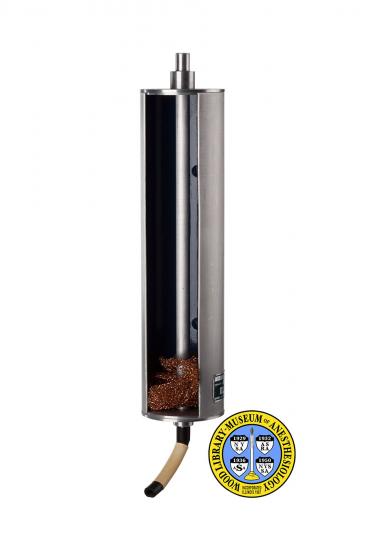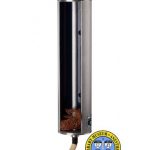Boehringer Gas Scavenger
Gas scavenging systems are a part of all modern anesthesia machines, which are complex devices used for the administration of anesthetics, the support or control of breathing, and patient monitoring. Gas scavenging systems help prevent operating room air from accumulating more than trace amounts of inhalation anesthetics, like nitrous oxide, isoflurane, or desflurane.
This is one type of ‘interface’ for an anesthetic gas scavenger. It was designed in 1975 by engineer John R. Boehringer and manufactured by Boehringer Laboratories of Pennsylvania.
The main body of this type of interface is a cylindrical reservoir that is open to the atmosphere. Excess gas from the anesthesia machine is directed into the reservoir from the top and through the metal tube in the center. The inner metal tube opens near the base, within wire mesh. The mesh quiets the hissing sound of the flowing gas. At times excess gas may be released into the reservoir faster than the constant suction from the disposal system is able to carry it away. The reservoir is large enough to temporarily hold excess gas and keep it from entering the room air. Suction from the disposal system is connected to the tube that exits at the base of the reservoir.
Mr. Eddie Bowie of the University of Chicago created ‘cutaways’ from pieces of equipment used in anesthesia machines to help anesthesiology students and residents learn how anesthesia machines functioned. He carefully cut the body of this interface open to expose the inner parts.
Catalog Record: Boehringer Gas Scavenger
Access Key: akus
Accession No.: 2000-01-25-2 AC
Title: [Dissected Boehringer gas scavenger, on acrylic stand.]
Author: Bowie, Eddie.
Corporate Author: Boehringer Laboratories.
Title variation: Alt Title
Title: Open interface for a gas scavenging system.
Title variation: Alt Title
Title: Tube-within-a-tube scavenging system.
Title variation: Alt Title
Title: coaxial scavenging system.
Publisher: Wynnewood, PA : Boehringer Laboratories, [between 1977 and 2000].
Physical Descript: 1 model gas scavenger interface : metals, plastics, rubber ; 43.5 x 17 x 30 cm.
Subject: Gas Scavengers.
Subject: Air Pollution, Indoor – prevention & control.
Note Type: General
Notes: Title based on the WLM common name for the device; Alternate titles are
descriptive and based on the 1994 text titled, Understanding Anesthesia
Equipment, by Dorsch and Dorsch.
Note Type: General
Notes: The early date (1977] in the date range for the possible year of manufacture
is based on the year (1977) that the device was patented. The end date is
based on the year that Mr. Bowie donated this item to the WLM. The date range
could change if documentation indicates it should be corrected.
Note Type: Citation
Notes: Boehringer JR, inventor. Safety interface for anesthesia vacuum scavenging.
US patent 4,004,585. January 25, 1977.
Note Type: Citation
Notes: Dorsch JA, Dorsch SE. Controlling trace gas levels. Understanding Anesthesia
Equipment: Construction, Care and Complications. 3rd ed. Baltimore: Williams
& Wilkins; 1994:289-300.
Note Type: Citation
Notes: Ehrenfeld JM, Areti YK. Medical gas supply, vacuum, and scavenging. In:
Vacanti CA, Sikka PK, Urman RD, Dershwitz M, Segal BS, eds. Essential
Clinical Anesthesia. Cambridge: Cambridge University Press; 2011:126-128.
Note Type: Citation
Notes: OSHA Directorate of Technical Support and Emergency Management. Anesthetic
gases: guidelines for workplace exposures. Occupational Safety & Health
Administration website. https://www.osha.gov/dts/osta/anestheticgases/#A.
Published July 20, 1999. Revised May 18, 2000. Accessed April 3, 2014.
Note Type: Citation
Notes: Trentman TL. Scavenging waste gases benefits the staff but may harm the
patient. Marcucci C, Cohen NA, Metro DG, Kirsch JR, eds. Avoiding Common
Anesthesia Errors. Philadelphia: Wolters Kluwer/Lippincott Williams &
Wilkins; 2008:405-409.
Note Type: Physical Description
Notes: One open interface for a gas scavenging system; This might be referred to as
a tube-within-a-tube, or coaxial, scavenging system; The measurements
provided in the physical description include the acrylic base; Without the
base the measurements are approximately 40 x 7.5 x 9.5 cm; The main body of
the interface is a cylindrical canister, or reservoir, with a longitudinal
section removed to expose a long metal tubes inside; A port for the exhaust
tube protrudes from the top of the canister and is continuous with the inner
tube; Two holes puncture the sides of the top of the canister; These The
inner tube open at about 5 cm above the bottom of the canister; Sitting in
the bottom of the canister is a copper colored wire mesh; These act as vents
to provide positive and negative pressure relief; A black and yellow rubber
tube, for gas disposal, exits the bottom of the canister; A sticker on the
exterior of the canister, at the base, is stamped and marked with the
following, somewhat difficult to read, text, “SCAVENGER [new line] CATALOG #
5300 [new line] BOEHRINGER [new line] BOEHRINGER LABORATORIES WYNNEWOOD, PA
19096”.
Note Type: Reproduction
Notes: Photographed by Mr. Steve Donisch, September 16, 2013.
Note Type: Historical
Notes: Gas scavenging systems are a part of all modern anesthesia machines, which
are complex devices used for the administration of anesthetics, the support
or control of breathing, and patient monitoring. Gas scavenging systems help
prevent operating room air from accumulating more than trace amounts of
inhalation anesthetics, like nitrous oxide, isoflurane, or desflurane.
This is one type of ‘interface’ for an anesthetic gas scavenger. It was
designed in 1975 by engineer John R. Boehringer and manufactured by
Boehringer Laboratories of Pennsylvania.
The main body of this type of interface is a cylindrical reservoir that is
open to the atmosphere. Excess gas from the anesthesia machine is directed
into the reservoir from the top and through the metal tube in the center. The
inner metal tube opens near the base, within wire mesh. The mesh quiets the
hissing sound of the flowing gas. At times excess gas may be released into
the reservoir faster than the constant suction from the disposal system is
able to carry it away. The reservoir is large enough to temporarily hold
excess gas and keep it from entering the room air. Suction from the disposal
system is connected to the tube that exits at the base of the reservoir.
Mr. Eddie Bowie of the University of Chicago created ‘cutaways’ from pieces
of equipment used in anesthesia machines to help anesthesiology students and
residents learn how anesthesia machines functioned. He carefully cut the body
of this interface open to expose the inner parts.
Note Type: Acquisition
Notes: Donated to the WLM by Mr. Eddie Bowie.
Note Type: Exhibition
Notes: Selected for the WLM website.


